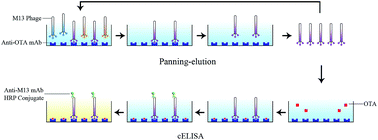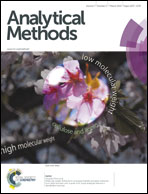Selection of phage-displayed minotopes of ochratoxin A and its detection in cereal by ELISA
Abstract
A competitive ELISA (cELISA) for the quantitative detection of ochratoxin A (OTA) was developed that uses a clone selected from a phage random peptide display library. An anti-OTA monoclonal antibody (mAb) was employed as the target for clone selection from a phage random heptapepide library. After four rounds of panning, 22 positive phage clones, in which binding to anti-OTA mAb could be blocked by free OTA, were obtained. The peptide sequences were deduced from DNA sequencing, and the consensual amino acid sequence of the selected peptides is MPLWXDL (X is any amino acid residue). A cELISA for detecting OTA was established using the selected phage clones. In the most sensitive assay, the linear range of the inhibition curve was 125–8000 pg mL−1. The half-inhibitory concentration (IC50) was 481.8 pg mL−1 and the detection limit was 103.2 pg mL−1. The analysis of 15 domestic cereal samples in parallel using this cELISA, a commercial ELISA kit and HPLC demonstrated the effectiveness of the method for detection of OTA in cereal samples.


 Please wait while we load your content...
Please wait while we load your content...